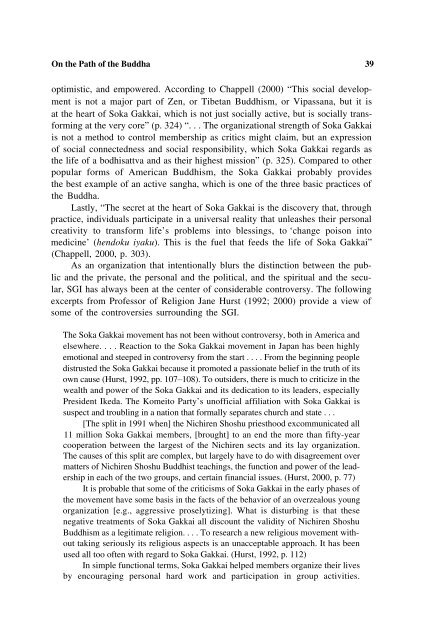Psychology & Buddhism.pdf
Psychology & Buddhism.pdf
Psychology & Buddhism.pdf
You also want an ePaper? Increase the reach of your titles
YUMPU automatically turns print PDFs into web optimized ePapers that Google loves.
On the Path of the Buddha 39<br />
optimistic, and empowered. According to Chappell (2000) “This social development<br />
is not a major part of Zen, or Tibetan <strong>Buddhism</strong>, or Vipassana, but it is<br />
at the heart of Soka Gakkai, which is not just socially active, but is socially transforming<br />
at the very core” (p. 324) “. . . The organizational strength of Soka Gakkai<br />
is not a method to control membership as critics might claim, but an expression<br />
of social connectedness and social responsibility, which Soka Gakkai regards as<br />
the life of a bodhisattva and as their highest mission” (p. 325). Compared to other<br />
popular forms of American <strong>Buddhism</strong>, the Soka Gakkai probably provides<br />
the best example of an active sangha, which is one of the three basic practices of<br />
the Buddha.<br />
Lastly, “The secret at the heart of Soka Gakkai is the discovery that, through<br />
practice, individuals participate in a universal reality that unleashes their personal<br />
creativity to transform life’s problems into blessings, to ‘change poison into<br />
medicine’ (hendoku iyaku). This is the fuel that feeds the life of Soka Gakkai”<br />
(Chappell, 2000, p. 303).<br />
As an organization that intentionally blurs the distinction between the public<br />
and the private, the personal and the political, and the spiritual and the secular,<br />
SGI has always been at the center of considerable controversy. The following<br />
excerpts from Professor of Religion Jane Hurst (1992; 2000) provide a view of<br />
some of the controversies surrounding the SGI.<br />
The Soka Gakkai movement has not been without controversy, both in America and<br />
elsewhere. . . . Reaction to the Soka Gakkai movement in Japan has been highly<br />
emotional and steeped in controversy from the start . . . . From the beginning people<br />
distrusted the Soka Gakkai because it promoted a passionate belief in the truth of its<br />
own cause (Hurst, 1992, pp. 107–108). To outsiders, there is much to criticize in the<br />
wealth and power of the Soka Gakkai and its dedication to its leaders, especially<br />
President Ikeda. The Komeito Party’s unofficial affiliation with Soka Gakkai is<br />
suspect and troubling in a nation that formally separates church and state . . .<br />
[The split in 1991 when] the Nichiren Shoshu priesthood excommunicated all<br />
11 million Soka Gakkai members, [brought] to an end the more than fifty-year<br />
cooperation between the largest of the Nichiren sects and its lay organization.<br />
The causes of this split are complex, but largely have to do with disagreement over<br />
matters of Nichiren Shoshu Buddhist teachings, the function and power of the leadership<br />
in each of the two groups, and certain financial issues. (Hurst, 2000, p. 77)<br />
It is probable that some of the criticisms of Soka Gakkai in the early phases of<br />
the movement have some basis in the facts of the behavior of an overzealous young<br />
organization [e.g., aggressive proselytizing]. What is disturbing is that these<br />
negative treatments of Soka Gakkai all discount the validity of Nichiren Shoshu<br />
<strong>Buddhism</strong> as a legitimate religion.... To research a new religious movement without<br />
taking seriously its religious aspects is an unacceptable approach. It has been<br />
used all too often with regard to Soka Gakkai. (Hurst, 1992, p. 112)<br />
In simple functional terms, Soka Gakkai helped members organize their lives<br />
by encouraging personal hard work and participation in group activities.











